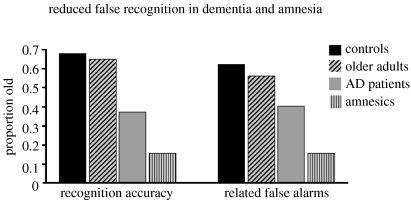Figure 1.
Performance of patients with amnesia and Alzheimer's disease on the Deese–Roediger–McDermott (DRM) paradigm (Roediger & McDermott 1995). Participants study lists of words (e.g. tired, bed, awake, rest, dream, night, etc.) that are related to a non-presented lure word (e.g. sleep). A subsequent old–new recognition test contains studied words (e.g. tired, dream), new words that are unrelated to the study list items (e.g. butter) and new words that are related to the study list items (e.g. sleep). Both patient groups show significantly reduced recognition accuracy (i.e. hits—false alarms to new unrelated words) and also make fewer related false alarms (i.e. false alarms to new related words—false alarms to new unrelated words) relative to age-matched controls. Note that the ‘controls’ were the age-matched control group for the amnesic patients (data for controls and amnesics are obtained from Schacter et al. 1996c) and the ‘older adults’ were the age-matched control group for Alzheimer's patients (data for older adults and Alzheimer's patients are obtained from Budson et al. 2000). AD, Alzheimer's disease.

